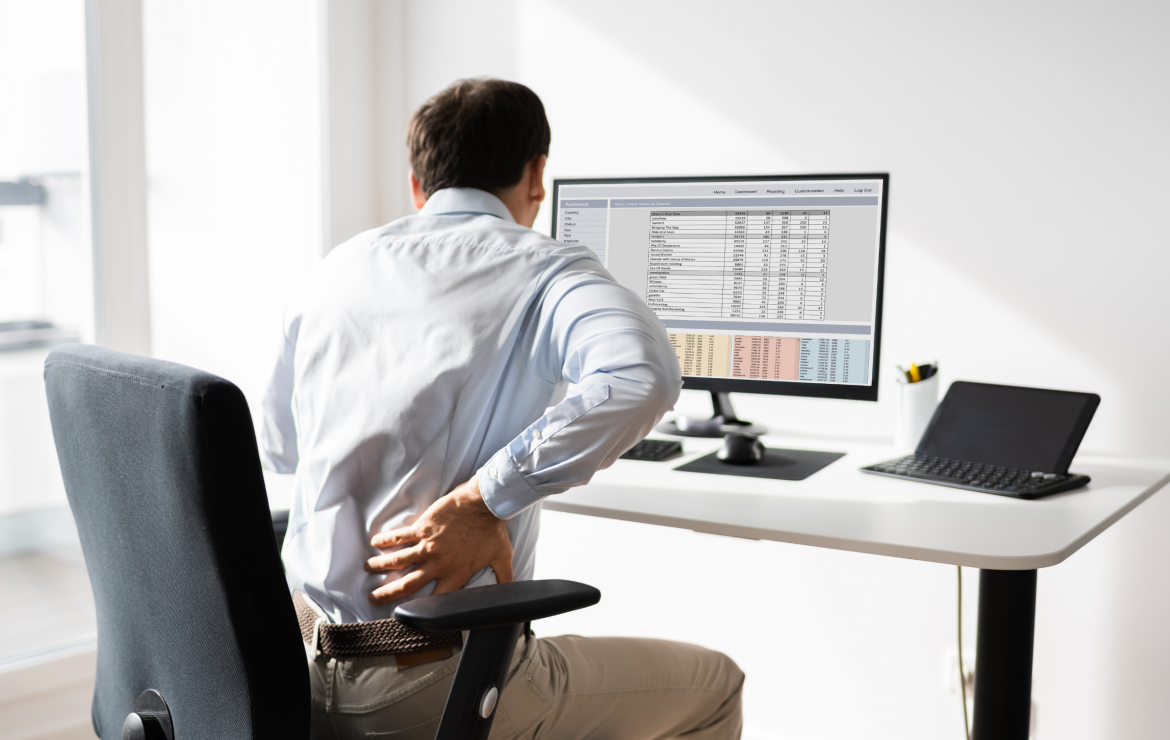Promoting office health means caring for the health of employees and protecting them from the occupational risks they may face in the office, as the nature of their job forces these employees to sit for many hours in the office in front of computer screens.
These office workers represent the largest segment of the workforce in most government and private institutions.
It’s a common misconception that people working at a desk are not exposed to health risks, as every field of work has its risks, which vary according to the work environment, for example, factories, hospitals, and oil sites are classified as high-risk work environments, due to the higher occupational injuries compared to other institutions or office work environments.
However, studies indicate that working long hours in an office can cause many diseases and health problems that ultimately affect performance and productivity in these institutions.
Office workers’ occupational risks:
1. Staring at computer monitors for hours without taking a break can cause headaches and eye problems, as nearly 70% of office employees suffer from symptoms of computer vision syndrome, caused by eyestrain.
These symptoms include blurry vision, dryness, pain, burning, and itching in the eyes, headaches, and in some cases glaucoma.
2. The unhealthy posture, which leaves the head and neck in a bent position, or bending the neck to the side while using the telephone causes pain and spasms in the neck.
3. Sitting at the desk for a long time, sometimes many hours without taking a break causes back and spinal pain.
The human spine contains vertebrae separated by soft spongy discs that act as shock absorbers, but sitting for a long time at the desk puts these discs under greater pressure compared to other postures such as standing, and over time, these discs get deformed and begin to move, causing unbearable pain.
4. Carpal tunnel syndrome is one of the most common office diseases due to the repetitive movement involved in typing on the computer or using the mouse for a long time without taking breaks.
This syndrome can lead to the inflammation of the nerves, ligaments, and joints, causing pain in the wrists, numbness in the fingers, and weakness in the muscles of the hand.
5. The lack of a healthy diet and physical activity associated with sitting for long hours can increase the risk of developing chronic diseases such as diabetes, heart disease, obesity, and high cholesterol.
6. Tripping and falling due to the improper placement of tools or exposed electrical wires on the floor or slipping due to wet or uneven floors, loose carpets, and crowded areas.
7. Other occupational hazards include:
Carrying, handling, and transporting office equipment and supplies.
Bullying in the workplace.
Noise in the workplace.
Poor work conditions, such as inadequate lighting and ventilation, and overcrowded offices, all of which can lead to an increase in occupational asthma and other respiratory disorders and allergies.
Studies indicate that the negative effects of office work, such as spinal and muscle pain, lead to a severe form of general fatigue and exhaustion, which in turn causes the office worker psychological problems such as anxiety, stress, and depression.
Risk Prevention
1. The right posture
The first step in the process of office-work risk prevention is the correct posture, thus the desk and chair measurements must be compatible with the employee’s height, and physical composition.
The correct posture can be achieved through the following points:
The chair: the right posture starts with choosing the appropriate chair, which must be comfortable and has an adjustable back so that you can adjust it to the right height to make your feet flat on the ground and your palms and wrists flat on the desk, to reduce exposure to repetitive stress injuries.
Furthermore, the elbows should be on the sides so that the arms and the elbow joint form an L-shape, in addition, the thighs must be at a right angle to the body (parallel to the floor).
The back: the worker’s back must be straight not curved, which can be achieved by placing the chair close to the desk.
The computer screen: the screen must be centered at eye level so that the head is straight.
The mouse: the computer mouse must be placed as close to the body as possible so that the user does not have to extend his/her upper arm to reach it.
2. The phone
Avoid placing the phone between your ear and shoulder, which causes stress and pain in the muscles of the neck, instead use headphones.
3. Sitting for a long time
Avoid sitting for a long time without taking frequent breaks, which can be short, such as walking around the office, as physical activity helps renew blood circulation, and experts recommend taking 1 to 2-minute breaks every 20 minutes.
4. Air conditioning and ventilation
Make sure there are proper air conditioning, ventilation, and adequate lighting in the office, with moderate indirect light reaching the workstations.
5. Diet
Organizing meals and eating healthy foods such as vegetables, fruits, and nuts that boost energy levels without increasing calorie consumption, drinking sufficient amounts of water, reducing caffeine, and replacing it with healthy drinks.
6. Exercise
Doing office exercises and making them a part of your daily lifestyle at work and focusing on exercises that strengthen the eyes as well as the muscles of the neck, back, shoulders, hands, and feet.
In conclusion, office work entails some hidden health risks, which, if dealt with appropriately from the start can spare the worker a lot of chronic pain in the long run.
By: Dr. Badreyya Al-Harmi, Consultant Public Health, Emirates Public Health Association













